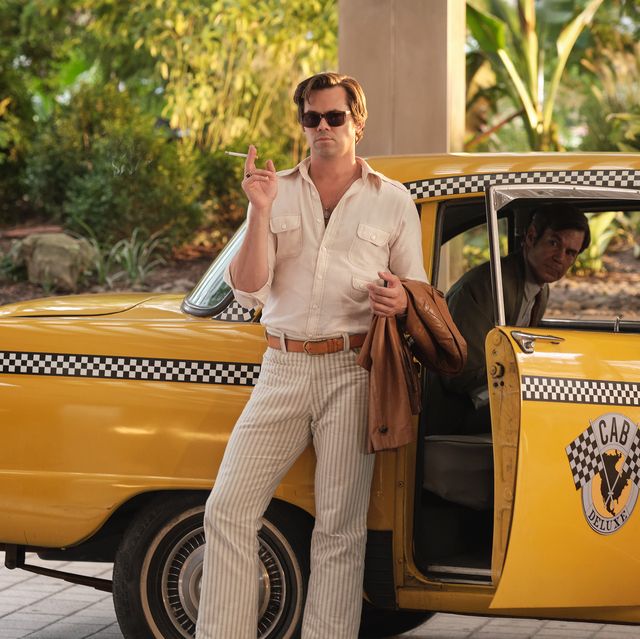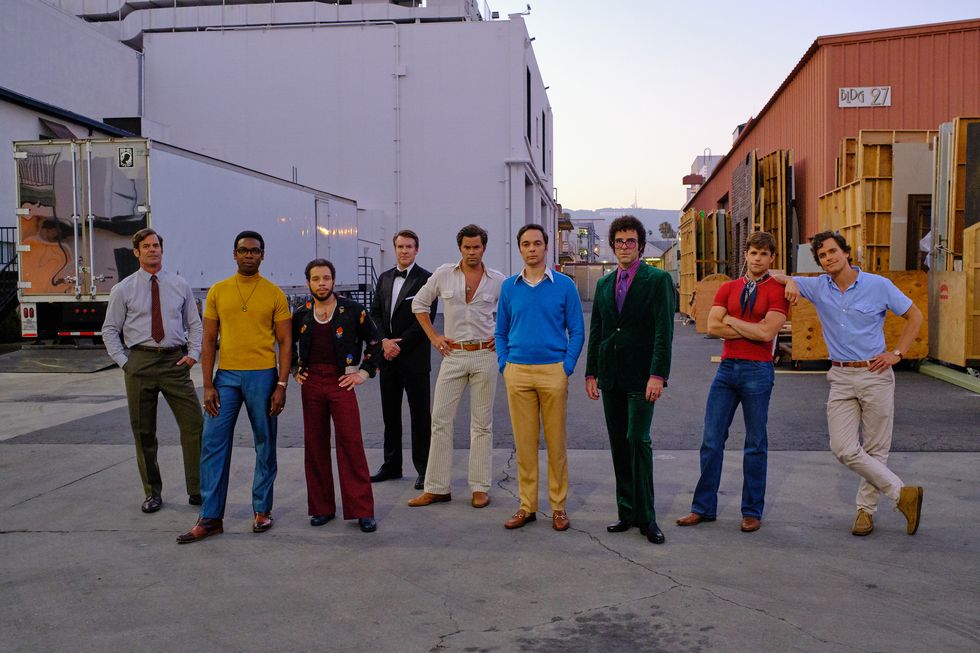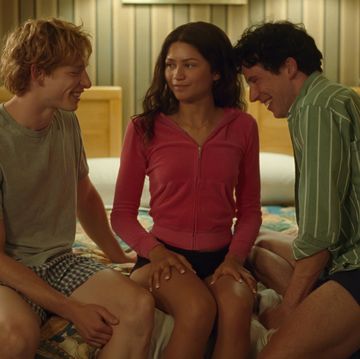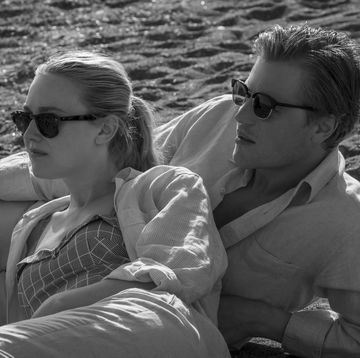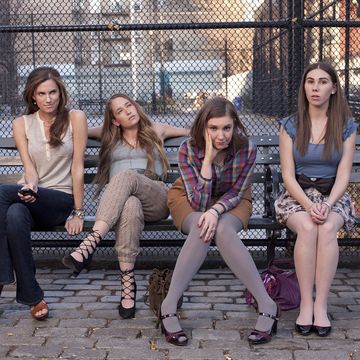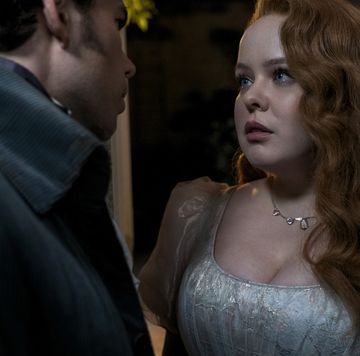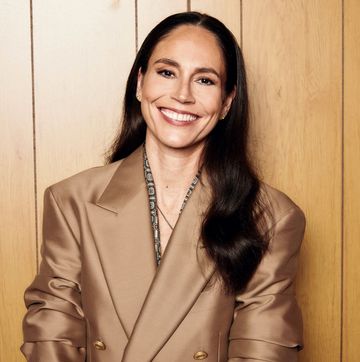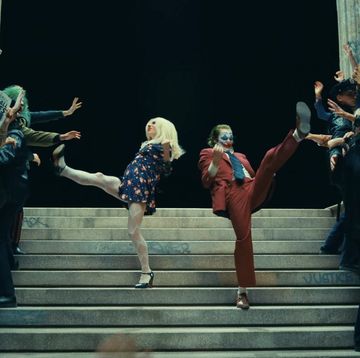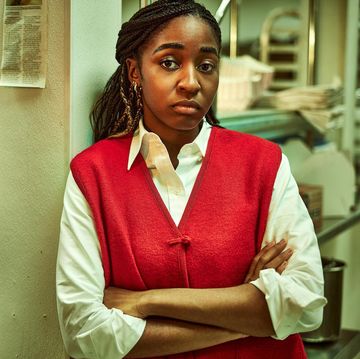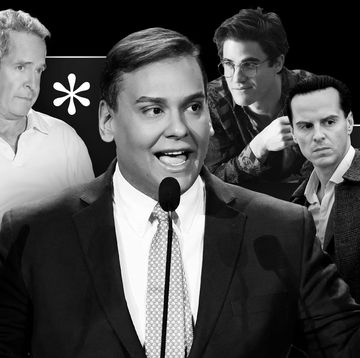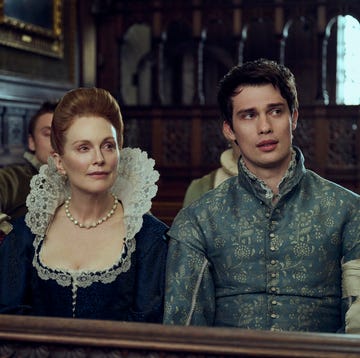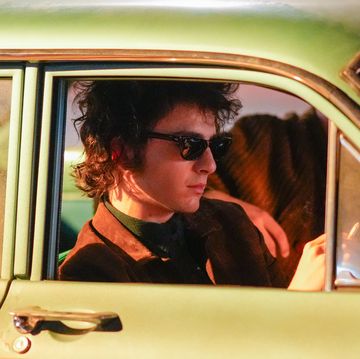Andrew Rannells warns against drunk phone calls. “Drunk prank calling or phone calls are never a good idea, and I’m saying that from experience,” he tells BAZAAR.com. “There’s really no reset.”
Yet, that’s the catalyst for much of the shenanigans that transpire in Netflix’s The Boys in the Band, a Ryan Murphy–produced adaptation of the 1968 off-Broadway play by Mart Crowley. Centering on a group of gay men who gather for a birthday party in New York City, the story chronicles a night of drinking and truth telling. As a sudden rainstorm locks the guys indoors, they turn their attention to a game: Each guest must call someone whom he has loved and confess it. As one can guess, the night devolves into chaos. Much of the drama stems, however, not from too much booze, but rather the histories and insecurities boiling under the surface.
The Boys in the Band first got the film treatment back in 1970 and was then brought back to Broadway in 2018 for its 50th anniversary, nabbing the Tony for Best Revival of a Play. Directed by Joe Mantello, the latest film adaptation sees the stacked cast of that production return: Rannells, Jim Parsons, Zachary Quinto, Matt Bomer, Charlie Carver, Robin de Jesus, Brian Hutchison, Michael Benjamin Washington, and Tuc Watkins.
Rannells brings to life Larry, a charismatic fashion photographer who just can’t resist a drink at Julius’ with cute boys he encounters in the Village—much to the chagrin of his partner, Hank, played by IRL partner Watkins. (The two actually met doing the stage revival.) Larry and Hank’s relationship—and figuring out what level of openness and intimacy with others they’re comfortable with—is still one that resonates with many queer people navigating dating today.
It’s been a busy year for Rannells, with the sophomore season of the criminally entertaining Black Monday (add it to your queue ASAP) coming to a close earlier this year and the October return of Big Mouth, in which he voices gay teen Matthew. Oh, yeah, and The Boys in the Band is now streaming on Netflix.
Speaking to BAZAAR, Rannells opens up about the play’s relevance today, falling in love, and Hollywood’s occasional and unwritten “one gay actor” rule.
How did you originally get involved with the 2018 revival for Broadway?
Ryan Murphy asked that group of us to do a reading of it with Joe Mantello. We sort of did it as an exploration of is there value in doing this and how does it read after 50 years? Ryan had had this great vision for the 50th anniversary of bringing it to Broadway—the original production was off Broadway—for Mart Crowley to finally have the show be on Broadway. I think it was a huge deal.
I was just so struck by how contemporary it felt. A lot of the conversations that the characters have in that play are still things we're talking about today. As a gay man and as a New Yorker, it landed very squarely, and it felt very relevant right now. What Joe did with the film adaptation of it is really beautiful. He's able to sort of take what we did on Broadway, flip it around a little bit, and make it into a much more intimate version of telling that story.
You’ve been on so many different sets, but how does the dynamic shift for a project like this when it’s just a bunch of queer men producing art together?
The thing that was great about it is we were all on the same page when we started. Because we knew queerness was the underlying theme, we got to focus more on the human interaction and what are the relationships we're dealing with. It was very freeing. As much as we all knew each other, none of us have really worked that much together. There's sort of this strange, unwritten rule sometimes in Hollywood that you can have, like, one gay actor, but you can't have two. So most of us were used to playing opposite straight actors in romantic relationships. The fact that it's just a room of nine gay men getting to do this together is really special.
Because it is such an intimate setting, I noticed a lot of slight taps or characters making eye contact while others are speaking. How was it layering in those small details?
Tuc and I got to explore that relationship on a much deeper level. We had a great run on Broadway, and I think we figured out a lot of the details of that relationship. But doing it on film, we were able to sort of layer in even smaller moments. Joe was so helpful in helping us all find those little places that make them more human. So Tuc and I, the way we bicker, the way I roll my eyes, all of that sort of got to be more fleshed out.
We met doing Boys in the Band, and we play sort of a very complicated relationship with Hank and Larry. So falling in love with someone in real life while you're playing sort of a bickering couple, it's a very strange experience.
Was it nostalgic revisiting that for the film?
I mean, we really did fall in love doing the play on Broadway. Then you get to come back together and just have all of that time together, it's such a treat.
A lot of the themes of this film have to deal with queer men finding self-acceptance. How have you seen these conversations change over the years?
1968 was obviously a very difficult time to be a queer person. While I feel like we've made great strides in the 50 years since Mart wrote the play, what Jim's character, Michael, says at the end about if only we could not hate ourselves so much, I feel like that line still resonates. That’s because people—not just queer people, but everybody—are very hard on themselves.
Particularly, you know, right now in the past few months, a lot of us have had a lot of time for self-introspection. We are hard on ourselves. We judge ourselves sometimes the most harshly, which is why I feel like it's still so resonant. The whole play is about self-acceptance and being okay with who you are and being where you are.
Tell me a bit about the tension between Hank and Larry when it comes to getting on the same page about their relationship.
I think Hank is coming from a sort of heteronormative template. He was married, [had] kids. That's sort of the path that Hank is on. That's what he's used to. Larry is trying to, you know, sort of make his own rules as he goes around. And I feel like that's also a relevant conversation today. Like, if you don't have the template of what a traditional relationship is supposed to look like, what do you make it into? Larry's idea is that there's going to be some different boundaries that I think Hank is experiencing.
What are you looking forward to with this story going from Broadway to Netflix?
I'm super excited that we can share it with more people, obviously. The fact that particularly right now, as people are mostly just in their homes, hopefully, it reaches a larger audience. I really hope that young people, particularly young queer people, find it and watch it and can relate to it. To look at it as sort of how far we've come and also how far we have to go still as a community.
I think the reason that it still lands squarely with audiences even years later is because what Mart is talking about are our conversations that we're still having today. This was the year before Stonewall, when this play was written. Sometimes, and I know I do this, too, but folks younger than me maybe take for granted a little bit, like, just how much work and how hard people who came before us really had to struggle to get where we are today.
While it's not a hugely political play, it's really a human drama about these nine men interacting, but the larger tones and repercussions of what they're talking about are still things that we deal with today.
Why is it so important that we’re able to see these nine different gay characters interact with one another while having their different histories?
Sometimes I'll get asked, like, "Do you feel pigeonholed playing gay characters?" My response to that is always, "That implies that there's only one type of gay person, that there's only one way to do it." What is so interesting about The Boys in the Band is that it's nine distinct characters. Yes, they all are gay. But they all have very different experiences, and they all behave very differently. It's nine versions of what it is to be a gay man at that time.
If there were to be another birthday party for Harold next year, where do you think Larry and Hank would be then?
They would still be together. Hopefully, not fighting so much. That's what's so beautiful about those two characters. Larry is in love with him. He loves him. He wants to be with him. They're the only couple in that entire play. He's just scared as to what that actually means. What is that supposed to look like? Can I still have a part of myself, but also be involved with this man? That struggle, it's not that he doesn't love him, he's totally in love with him. He's just afraid of what that might mean for himself.
This interview has been edited and condensed for clarity.
Gabe Bergado is a writer, editor, and comedian based in Brooklyn. His work has appeared in Elle, GQ, Nylon, Bon Appétit, The Daily Beast, and more. He's the former entertainment features editor of Teen Vogue. He's probably rewatching Buffy the Vampire Slayer — again.
